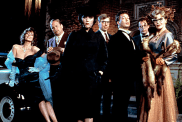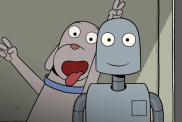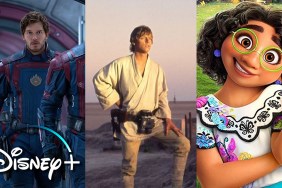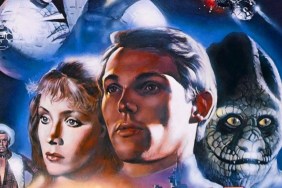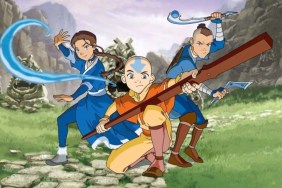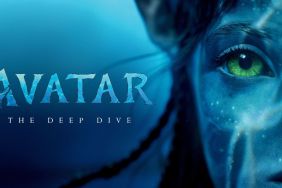
Taking the stage in a suitably Na’vi-colored auditorium, James Cameron greeted an audience of press from across the globe, eager to show off some of the brand-new features of the Avatar Extended Collector’s Edition. The three-disc set (hitting shelves today) features a longer cut of the film and roughly eight hours of immersive behind-the-scenes material.
“[Today is] tremendously exciting for us,” Cameron announced, “because we’ve got back together the whole ‘Avatar’ team in the process of putting together this day… The purpose of the Special Edition disc set that we’re promoting is to celebrate the team and the effort behind the film. To help the fans in the film community understand at large how the film was made with all the new pioneering techniques, what it took in terms of the artistry, what it took on the part of the cast to step up to a new set of challenges and how, in fact, the characters that were celebrated around the world were really the heart and soul of what the actors created.”
Taking on the role of camp counselor, Cameron oversaw as the room was divided into teams that would spend the rest of the day exploring ten different subsections of the world of Pandora. As for Cameron himself, the filmmaker made regular appearances, popping up as an observer. It made for an incredible (but surreal) experience, sitting and learning the Na’vi language and then turning to find Cameron trying to sound out the words himself two seats over.
Beginning with a session called “Make the Cut,” editors John Refoua and Stephen Rivkin showed off some of the intricate technology involved in the editing stage of Avatar. Because performances are captured in a 3D environment, editing becomes substantially more complex than for a regular film where only what has been shot stands a chance of making it to the screen. Refoua and Rivkin showed off a multi-tiered editorial timeline with rough renderings of each character and, while there are default shots applied, the positioning of the camera can actually be moved around in the post-production process. The methodology then becomes locating the best takes and the desired position and duration of the image so that just the required amount of footage is all that moves into the final rendering stage.

“Amazon Watch A Message From Pandora” is featured in a short documentary on the set. The organization came to the attention of Cameron earlier this year. He was so impressed by their goal of conservation that he traveled to the Brazilian rainforest (bringing along a few Avatar actors) to meet with indigenous tribesmen along the Xingu River, whose very way of life is threatened by the planned construction of a massive electric dam. The documentary calls for action against the dam and donations to Amazon Watch, which can be made at their official website.
Moving on to “The Sounds of Pandora,” attendees were greeted by composer James Horner and Sound Mixer Juan Peralta. Though both men were responsible for the film’s audio, their respective approaches came from different angles. Peralta, in charge of diegetic sound, found one of the largest challenges the creation of otherworldly animal noises. Scouring the globe for recordings of real-world creatures (including spending some time with a microphone in a bird sanctuary), Peralta blended Earth audio into the sounds of Pandoran Banshees, Direhorses and Hexapedes. Horner, meanwhile, made use of the actual Na’vi language, translating thematic words from English that were then sung by a choir and orchestrated into the film’s musical score.
At “Characters, Creatures and Vehicles,” Concept Artist and Creature Designer Neville Page joined Character Effects Coordinator John Rosengrant for a hands-on walk-through of some of the physical props made for the film, including a massive mech-suit worn by Stephen Lang’s Colonel Quaritch and full-scale busts of several lead Na’vi faces. Interestingly, Sigourney Weaver’s face proved the hardest to translate because of her distinctive nose. In the final design for the film, Page pointed out that her character’s avatar has a bit of a cheat, featuring a more human-like nose than any of the other Na’vi.

“Designing the World” was hosted by Production Designer Robert Stromberg, Supervising Virtual Art Director Yuri Bartoli and Costume Designer Deborah Scott. Despite the computer-generated world of Avatar, many of the design elements had to be first constructed in reality, at least in part, to figure out the specific texture, weight and balance that the computer models would then mimic. The computer world itself exists in a sort of bubble with background elements playing out in real time. That means that, to the computer, fully realized creatures may be stomping through the Pandoran rainforest even when they’re not featured in the frame. Bartoli reminisced about some of the sleepless nights he had, trying to shift major elements of the computer world with only a few hours notice.
From there, journalists were escorted into a tremendous performance capture stage where one of the jungle scenes was set up to be acted out by two performers in full mo-cap suits. Lead by Motion Capture Supervisor Matt Madden, Digital Effects Supervisor Nolan Murtha, the actors recreated the first encounter between Jake Sully and Neytiri. While in person, the set looked like a soundstage, a hand-held console with a built-in monitor allowed for its user to walk through the scene and to see a basic rendering of the world as it would appear in the final film, setting up the shot in real time.

Just around the corner and still on the soundstage, Animation Supervisor Richie Beneham joined Virtual Production Supervisor Glenn Derry for a shot that would blend an actual life-size prop helicopter with a Chroma key backdrop and another camera designed to cooperate with the virtual environment. Inside the helicopter, an actor reacted to an imaginary Na’vi attack while the camera operator was able to go handheld, moving 360 degrees around a Na’vi actor that wasn’t actually there.
“A Look Through the Lens” featured Vince Pace who, along with Cameron, created the Fusion Camera System on which Avatar was shot. The multi-million dollar camera was set up with a live feed to a video monitor, allowing guests to watch themselves in 3D as Pace talked about the incredible technical specifics that went into the design.
A “Visual Effects” component featured WETA director Joe Letteri and former WETA artist (now with Digital Domain) Stephen Rosenbaum. Responsible for the ultimate look of the film’s effects, Letteri talked about the leaps and bounds that technology has come from CGI characters less than a decade old like Gollum in “The Lord of the Rings” and teased that future visual effects will only up the ante.
Finishing out the sessions was “The Na’vi World” with linguist Paul Frommer, responsible for the development of the Na’vi language and Jodie Holt, a botanist that was brought in to create realistic plant designs for the world of Pandora. Though it may seem slight in the grand scheme of things, both Frommer and Holt took their jobs very seriously, applying a significant degree of their own personal scientific expertise. Since the release of Avatar, the Na’vi language has seen incredible growth and Frommer has been contacted by would-be Na’vi linguists from around the world.

Leading everyone back into the main auditorium, Cameron showed off a few scenes from the Extended Edition Blu-ray, including a new opening that features Jake Sully’s life on Earth and clips from a feature-length documentary about the making of Avatar.
“We actually created a family friendly audio version of the film you can watch as well,” explained Cameron, defending one of the film’s more unexpected features, “That’s just because I was getting in trouble from my wife when our seven-year-old was watching… For the next two weeks he would go around saying s–t and g*dd*mn*t. Then I’d yell at him and he’d say, ‘Dad, it’s in ‘Avatar’!'”
Looking to the future, Cameron plans to shoot two Avatar sequels back-to-back and release them a year apart.
“In order to do that,” he said, “we have to refine our technical processes beyond the end of where we were finishing ‘Avatar 1’ essentially a year ago, because we need to future-proof ourselves out five or six years to the end of the third film… We’re in that process right now. Improve and upgrade.”
Before any production happens, though, the filmmaker has another pet project in the works, but it’s one that may won’t necessarily be making it to the big screen… Cameron is currently at work building a state-of-the-art submarine capable of traveling to incredible depths.
“I don’t care if there’s any footage,” he laughed, “I’m just going. Everything is not about filmmaking. Going to the deepest place in the world’s oceans, 36,000 feet down, that ain’t about making a film. That’s about the engineering required to do something like that. I have a great team of engineers working in Sydney right now and building later next year.”
The Avatar Extended Collector’s Edition is available in stores now on both DVD and Blu-ray.
